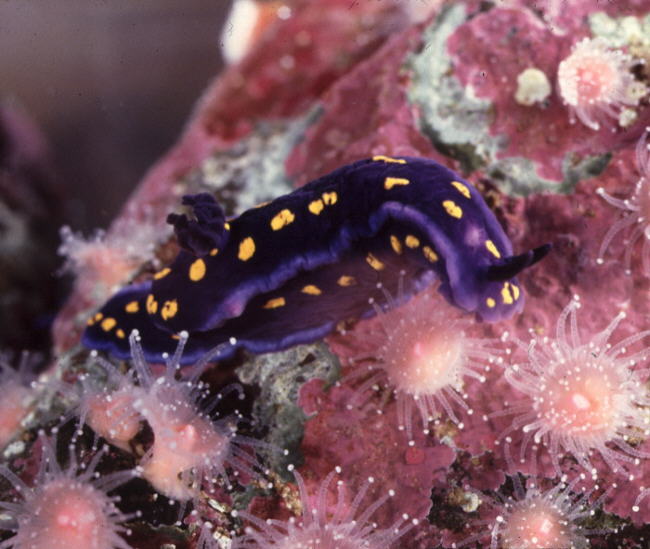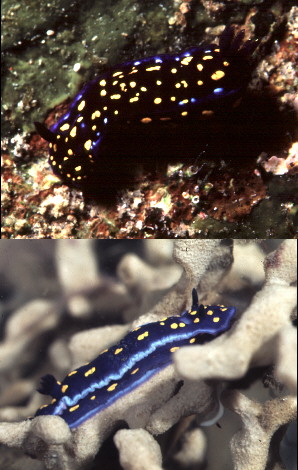 |
Hypselodoris californiensis
Photo courtesy of Dave Behrens
Aquarium shot, Pacific Biomarine, Venice, CA, circa 1971. Collection location unknown, but probably L.A. County.
Hypselodoris californiensis (Bergh, 1879)
I have always loved this species of northeastern Pacific chromodorid. One of the few temperate chromodorids, by comparison to the hundreds of tropical species, it numbers seem to have dwindled in past years, and I can't remember the last time someone has seen it. I have always loved the George Bush blue of its body color, and the electric lighting bolt gold color of its spots. I can't help but wonder if this species has left the state for lower electric rates, to keep those spots lit up bright. It's probably outraged also that the Bush is doing nothing to help the State with its energy current woes.
I hate to get political, but nudibranchs and California energy problems DO actually go hand in hand. Your web master, Senior Miller, has actually purchased a portable generator to keep this web page available to you, during the rolling black outs President. Bush, Governor Gray Davis and my previous utility employer (the largest investor owned electric utility in the US) are imposing on the Sixth largest economy in the world. Oh, well enough of this belly aching, as there is absolutely nothing any of us can do. Thanks to Mike however, for providing reliable, affordable service.
Top photo courtesy of the Webmaster
Bottom photo courtesy of Dave Behrens

|
Hypselodoris californiensis is distinct in having a light blue marginal
band as can bee seen in the bottom left photograph taken at Santa Barbara Island. South of here, in Mexican waters is a similar species, H.
ghiselini as pictured at the top left from Bahia de los Angeles, Baja California. This species has white spots on the body and yellow dots on
the Helmut Debelius (operating under his unique definition of
Indo-Pacific) has included the temperate H. californiensis in his book on
page 234. His reference to the species occurrence inside the Gulf of
California is questionable. To my knowledge the geographical range for this
species is still Punta Eugenia, Baja Mexico at the southern end to Monterey
bay, California, at the northern end. The species reaches 64 mm in length,
and feeds on the sponges, Stelletta and Haliclona. When Mike Miller asked me to provide this note, he was interested in hearing from any California divers or tidepoolers who may have seen this species in recent years. If you know of any observations please share them with Mike and I. Send Dave mail at seachalleng@earthlink.net and Mike at mdmiller@cts.com. Webmaster's Note: Veteran Branchologist Jim Lance of Pacific Beach, California reports his last field account of seeing H. californiensis in local (San Diego) tide pools was back in 1975. The only time I have seen it was on a SDUPS trip to the Channel Islands in the mid '80's. As luck would have it, I was out of film when the encounter was made! See also Scott Johnson's note on Bill Rudman's Sea Slug Forum regarding H. californiensis who shares a similar experience (one time encounter). Jim was kind enough to make available a photo of H. ghiselini alongside H. californiensis which clearly illustrates the differences pointed out by Dave. |
Update 01/31/01) As remarked by Bill Rudman, a real asset of Internet Forums is the almost instantaneous peer review they are subjected to. In this case Orso Campillo of La Paz, Baja California, Mexico got in contact to amend the record on the geographical range for Hypselodoris californiensis . The southern extension also includes Bahia de Los Angeles and La Paz in the inner Gulf of California The Webmaster was privy to this information having received a copy of Orso's Thesis, but was asleep at the switch when the BOW went up! What is even more extraordinary is the report by Orso that H californiensis an H ghiseline and H agassizii were seen on a recent diving trip to Isla Cerralvo and Punta Pericos just south of La Paz, Baja California.
Reference:
Campillo, Orso Juan Angulo, Thesis, Moluscos Opistobranquios de Baja California Sur, Mexico, Universidad Autonoma de Baja Califonia Sur, Marzo de 2000
Danville, Calif
Jan. 2001
Taxonomic information and photos courtesy of Dave Behrens

David W. Behrens
Author:
Pacific Coast Nudibranchs
Send Dave mail at seachalleng@earthlink.net
|
